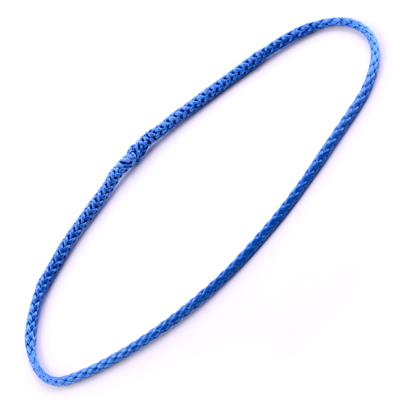February 19, 2016
posted in: Cordage
What Is Amsteel® Rope?
Amsteel® is a samthane coated, non-rotational, 12-strand single braid that is known for its low stretch and high strength. It has a similar strength to wire rope with 1/7th of the weight. In addition, the product is flexible, lightweight, durable, and abrasion-resistant and resists flex-fatigue.
Is Amsteel® the Same Thing as Amsteel® Blue?

They are not the same thing but are often confused. As an example, the average strength of 1/4” Amsteel® is 7400 pounds, while Amsteel® Blue is 8600 pounds. Samson’s Amsteel® is made from Dyneema® SK60. Amsteel® Blue is made from Dyneema® SK75. What is being sold by cottage vendors today is usually Amsteel® Blue, even if they don’t always call it that.
Does Amsteel® Blue have 8 Strands or 12 Strands?
It depends. The 7/64, commonly used for whoopie slings, has only eight strands, but diameters beyond that have twelve. The Samson documentation invariably lists Amsteel® Blue as a class 2 12-strand product. However, that documentation often does not include the 7/64 size because it is too small for the marine and industrial use that Samson serves. Class 1 ropes are manufactured from polyolefin, nylon and/or polyester fiber. Class 2 ropes (including Amsteel®) are manufactured from high-modulus fiber, such as Dyneema® Composite Fabrics.
What Is High-Modulus?
Samson defines Amsteel® as a “high-modulus polyethylene” rope. The high-modulus part means that Amsteel® has “low elasticity elongation,” or in other words, it doesn’t stretch much. However, this also means that this type of rope doesn’t like to be shock-loaded, so ease into the hammock! Safe working loads do not apply to shock loading.
What Is the Safe Working Load (SWL) of Amsteel® 7/64?
Working load (WL) is the load that a rope is subjected to during normal use. WLs are based on a percentage of the breaking strength (aka tensile strength) of new and unused rope. They are calculated by dividing the rope’s breaking strength (BS) by a safety factor (SF). The breaking strength of Amsteel® Blue 7/64 is 1600 pounds. Samson recommends that the maximum workload should be 1/5th, or 20% of the quoted breaking strength (safety factor = 5), and recommends a higher safety factor for uses that involve “life or limb.” The Cordage Institute recommends safety factors of 5 to 12 for non-critical uses, and 15 for lifelines. Here is the weight that a typical 7/64 Amsteel® Blue whoopie sling is rated to support, using the minimum safety factor recommended by Samson: SWL = BS / SF = 1600 / 5 = 320 lbs. Note: I had originally posted a calculation based on plain Amsteel, which gave rise to some of the responses below. Don’t get confused.
What Size Bury for Amsteel® 7/64?
Samson specifies that a fid is equal to the diameter of the rope x 21, and that an effective bury for Class 2 rope should be three and a half fids. The diameter of Amsteel® 7/64 is 0.11 inches, so for this rope, one fid is equal to 2.31 inches. So the recommended bury would be about 8 inches. Bury = fid x 3.5 = 2.31 x 3.5 = 8.01 inches. Note that the length of the bury is dependent on the diameter of the rope. Counterintuitively, the smaller the diameter of the rope, the shorter the bury needs to be. For example, a whoopie made with 1.75 mm Zing would only need five inches of bury (if following Samson specs), while one made with 1/8 inch Amsteel® would need nine inches.
To Stitch or Not to Stitch?
The eye of the whoopie sling is usually made with a locked Brummel, which does not require stitching. The eye, made in a variation of the “utility constrictor rope” (UCR), does require lock stitches (I like UCRs better than whoopies).
Why Use Splicing Instead of Knots?
Knots degrade the strength of the rope by up to 50 percent. A good splice should not reduce rope strength by more than 10 percent.
Dyneema® Vs. Amsteel®
Dyneema® uses ultra-high-molecular-weight polyethylene in its construction. This material has thin fibers that are long and straight, providing strength for the material. The industrial fibers originally began with a Dutch chemical company called DSM. Since then, other companies have started to produce similar products. Many manufacturers use Dyneema® to produce consumer goods, including ropes, tarps, nets, and other durable materials for outdoor use and heavy wear applications.
On the other hand, Amsteel® is a rope that consists of Dyneema® fibers. Because of their Dyneema® construction, lightweight Amsteel® ropes have a high strength-to-weight ratio and extreme resistance to water and UV damage.
Where Can You Buy Amsteel® Rope?
Dutchware sells a variety of Amsteel® Rope and Samson Rope. Shop by the foot or by the stool!
Related Outdoor Material Articles
- Backpacking Hardware Complete Guide
- DutchWare Hammock Hardware Ultimate Guide
- Choosing The Right Hammock Tarp
- Ultimate Guide to Hammock Suspension Straps
- Everything You Need To Know About Hammock Fabrics
Resources:
- Samson Rope User Manual https://www.samsonrope.com/Documents/…Manual_WEB.pdf Amsteel Blue as Class 2 rope (see page 8)
- https://www.samsonropecatalogs.com/home/100239.pdf Samson Rope Splicing Tutorials – Splicing Main Page (See Class II, 12-strand)
- https://www.samsonrope.com/Pages/SpliceInstructions.aspx – Eye Splice PDF https://www.samsonrope.com/Documents/…Splice_WEB.pdf – Eye Splice Video
- https://www.youtube.com/watch?v=EjR4…ature=youtu.be – Whoopie Sling PDF https://www.samsonrope.com/Documents/…l-Blue_WEB.pdf Other Splicing Tutorials
- https://www.youtube.com/watch?v=KtJGTgpv4dc Utility Constrictor Rope (UCR) Tutorials https://www.hammockforums.net/forum/…ty+constrictor https://www.youtube.com/watch?
- v=vbkojiRcEf0 https://www.youtube.com/watch?v=Yw6P3pHt8KI (5:26) https://www.youtube.com/watch?v=17_uXaEfZ9w https://www.youtube.com/watch?v=aBiGD–SOFg
- https://www.youtube.com/watch?v=Ch-bqE7OQZw Terminology https://www.ropecord.com/new/terminology.php#D

